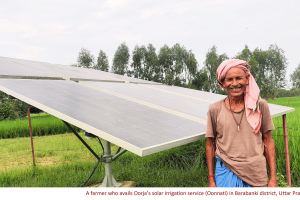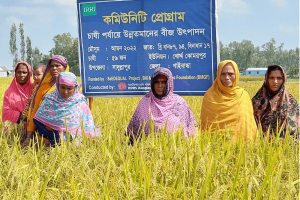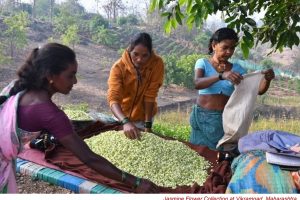Md Sirajul Islam, M Mahbubur Rashid, Ashick Ahmed and M Abid-Ul-Kabir share their experience of transplanting rice seedling using machine transplanter in Bangladesh
CONTEXT
Rice is the staple food of about 160 million people of Bangladesh. It provides nearly 48% of rural employment, about two-third of total calorie supply and about one-half of the total protein intakes of an average person in the country. Rice sector contributes one-half of the agricultural GDP and one-sixth of the national income in Bangladesh. Almost all of the 17 million farm families of the country grow rice. Rice is grown in about 10.5 million hectares (ha) of land which remains unchanged over the past three decades.
A field demonstration of machine transplanter during T. Aman 2012 in Rajshahi district
For successful rice cultivation, availability of quality seeds and seedlings, land preparation, transplanting seedlings in optimum time (with uniform spacing) are important. These are timeconsuming and expensive as labour cost accounts the biggest input for rice production. Though land is mostly prepared mechanically, raising of seedlings and transplanting are still being done manually in Bangladesh.
To produce rice from a hectare of land, about 156 person days are required. Of these 45 person days are needed for raising seedlings and transplanting which is about 29% of the total labour required. Though a contract system for undertaking transplanting evolved during this period, the careless attitude of contract labourers (aggressive pulling of seedlings from the nursery, clipping seedlings and transplanting at more depth with insufficient plant density, etc) to complete the work in the shortest possible time has been affecting the productivity of rice in Bangladesh. Though the work standards have been declining, these contract labourers have started demanding higher wages every year.
Box 1: A Brief History of Machine Transplanting in Rice
Mechanical transplanting in rice involves transplanting specifically raised younger seedling of rice as a mat (mat type nursery) using a self-propelled mechanical rice transplanter at predetermined and desired spacing. Machine transplanter was first developed in Japanin 1960s, whereas the earliest attempt to mechanize rice transplanting dates back to late 19th century. In Japan, development and spread of rice transplanters progressed rapidly during 1970s and 1980s. They also developed new technologies of seedling raising for rice transplanter (Tasaka et al., 1996). In Bangladesh, BRAC’s Agriculture and Food Security Programme and GBK (Golden Barn Kingdom) introduced walking type mechanical rice transplanter and tested in different project locations during wet season of 2012 and dry season of 2013 to evaluate the field performance.

INTERVENTIONS
Considering these issues, the Agriculture and Food Security Programme of BRAC and GBK (Golden Barn Kingdom) had taken a collaborative programme on machine transplanting of rice to disseminate this technology, with the following objectives:
- Ensure quality seedlings in proper time by raising seedlings in the tray under plastic shade
- Ensure uniform spacing and planting depth of transplanted rice
- Save time and cost during periods of peak-labour demand Seedling establishment in tray: needed for mechanical transplanting of rice
- Create new forms of employment through creation of seedling nursery entrepreneurs and transplanting service providers Improve farmers socio-economic conditions
Primarily 7.6 ha of 15 farmers at Talondo, Tanor of Rajshahi and 7.4 ha of 18 farmers at Tunipara, Sherpur of Bogra districts were selected to demonstrate machine transplantation versus manual transplantation in the wet season 2012. During the dry season (2012-13) the advantages of machine transplantation (in comparison to conventional agriculture) were evaluated. Machine transplanting showed better performance compared to manual transplanting and this convinced farmers to adopt this technology in future.
Box 2: Agriculture and Food Security Programme (AFSP) of BRAC and GBK
AFSP is trying to enhance food security and reduce hunger and malnutrition through promotion of environmentally sustainable agricultural production system. Besides agricultural research, development and marketing, the programme is also disseminating agricultural technologies through farmers’ participatory large scale block demonstration. The programme’s objectives are to engage in adaptive research in addressing emerging challenges in the agricultural sector, promoting higher production through cost effective and sustainable technologies, providing quality inputs and innovative financial and marketing services.
Golden Barn Kingdom Pvt. Ltd (GBK) is an agro input based multinational company that has made its debut in mechanized agriculture to boost rice production in Bangladesh. With this vision, the company has introduced the globally recognized ‘tray method’ in rice plantation to plant sapling through machines in the country’s rice fields.
GOOD PRACTICES

Survey and selection of participants:To introduce the new technology in farmers’ field, BRAC’S technical assistance team made a survey at the very beginning of the planting season. The following criteria were used for the final selection:
- Marginal farmer
- Engaged in agriculture either in own land or by lease
- Permanent resident of the locality
- National ID card and
- Interested in receiving training or orientation from the programme
Field supervision by BRAC’s Agronomist in Rajshahi district in





Add Comment